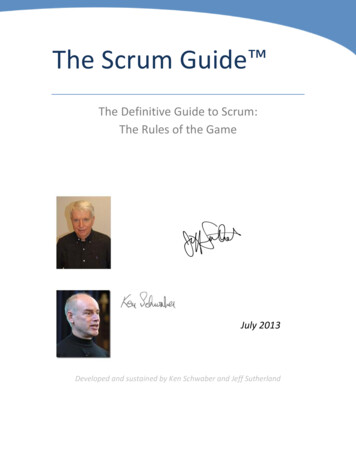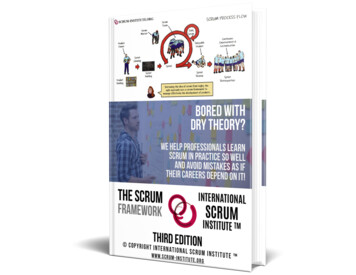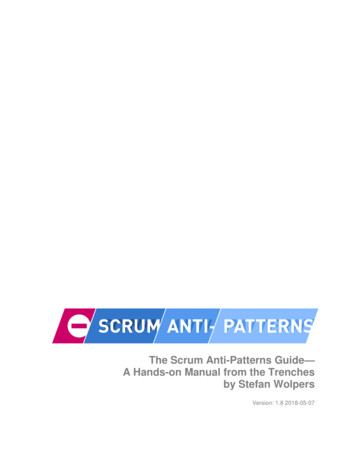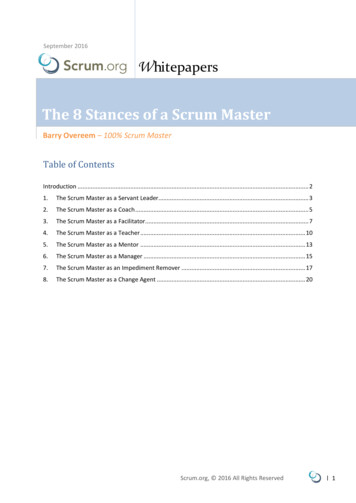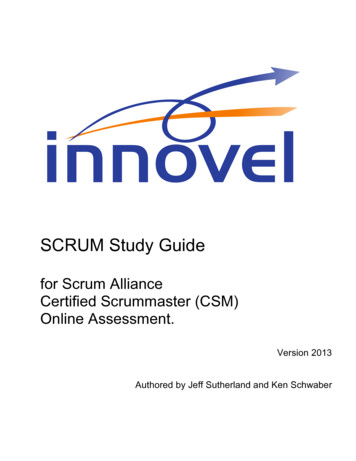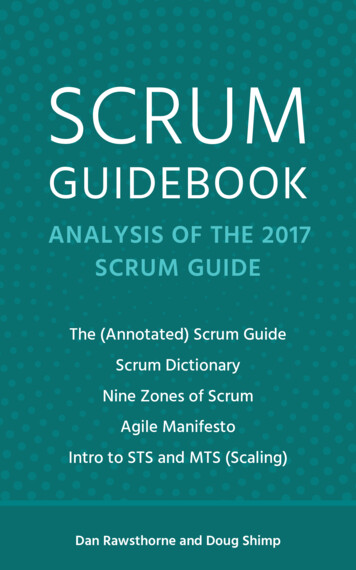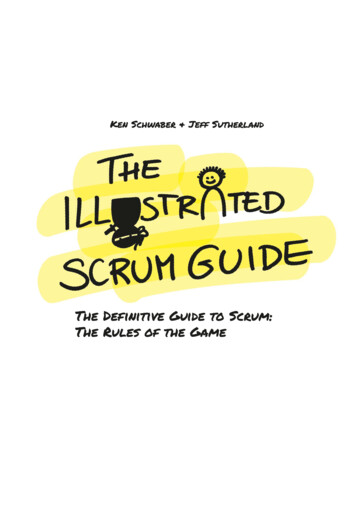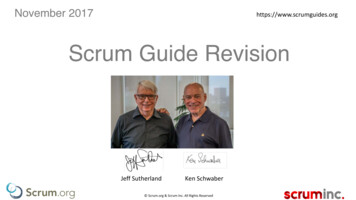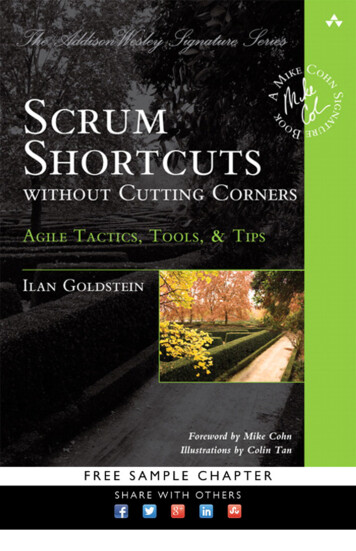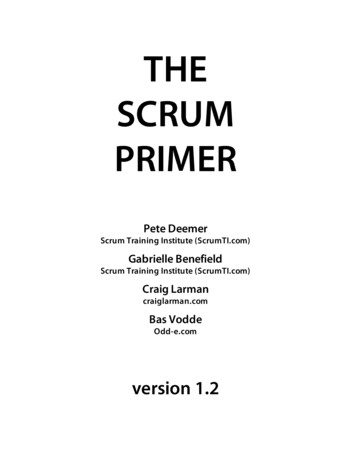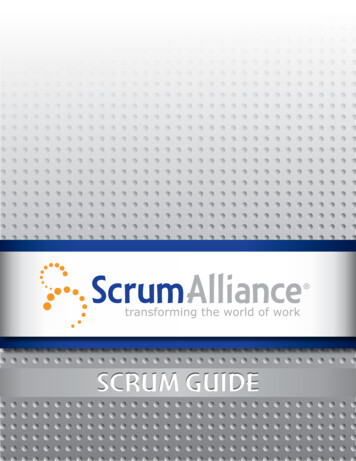
Transcription
SCRUM GUIDE
SCRUM GUIDEThis guide explains how to use Scrum to build products. In doing so, it will describe how theframework and its artifacts, time-boxes, roles and rules work together. Scrum does not includetechniques and processes for building products; however, it will point out the efficacy and flawsof these techniques and processes.Scrum is a framework for developing complex products and systems. It is grounded in empiricalprocess control theory*. Scrum employs an iterative, incremental approach to optimizepredictability and control risk. Within each iteration, Scrum employs self-organizing, crossfunctional Teams to optimize flexibility and productivity.The heart of Scrum is a Sprint. A Sprint is one iteration of a month or less that is of consistentlength throughout a development effort. All Sprints use the same Scrum framework, and allSprints end with an increment of the end product that is potentially releasable. The increment isa complete slice, or piece, of the finished product or system that is developed by the end of aniteration, or Sprint. One Sprint starts immediately after the prior Sprint ends.Scrum employs time-boxes to create regularity. The time-boxes within Scrum are :the Sprint Planning Meeting, the Sprint, the Daily Scrum, the Sprint Review,and the Sprint Retrospective.Scrum employs self-organizing, cross-functional Scrum Teamsto do the work. Each Scrum Team has three roles whereaccountability and responsibility lie. The ScrumMaster isresponsible for ensuring the process is understood and followed.The Product Owner is responsible for maximizing the valueof the work done. The Team does the work. The Team consistsof developers with all the skills to turn the Product Owner’srequests into the potentially shippable increment each Sprint.The Team is usually seven plus or minus two members.The Scrum framework consists of these time-boxes, Teams (withroles), and artifacts glued together by Rules. One rule is that onlythe people committed to turning the Product Backlog into anincrement, namely the Team, talks during a Daily Scrum.TIP: If there are fewerpeople on the team, theteam may reach skillconstraints during parts ofthe Sprint. If there are moremembers, the team maybe overwhelmed with toomany people to collaborateand to keep informed. Inour experience, however,teams do range outside thisrecommended size of sevenplus or minus two.* “Agile Software Development with Scrum,”Ken Schwaber, Microsoft Press, 2004SCRUM GUIDE02
Rules bind the roles, time-boxes and meetings. These rules areimplicit throughout this document as the roles, time-boxes andmeetings are described. When there are suggested approaches,or TIPS, on how to proceed, these are in separate TIP boxes.Scrum has been used to develop complex products since theearly 1990s. Many best practices have been uncovered fordeveloping complex products within the Scrum framework. Intandem with this guide, the books “Agile Project Managementwith Scrum” (Schwaber, Microsoft Press, 2004) and “The Enterpriseand Scrum” (Schwaber, Microsoft Press, 2007) contain many tipsabout managing projects and scaling Scrum.Scrum TheoryScrum is a framework for developing complex products andsystems that is grounded in empirical process control theory.*Empirical process control has three legs underlying all of itsimplementations: transparency, inspection, and adaptation.Transparency means that aspects of the process must be visibleto and understood by those controlling the process.TIP: When rules are notstated, the users of Scrumare expected to figure outwhat to do. Don’t try tofigure out a perfect solution,because the problemusually changes quickly.Instead, try somethingand see how it works.The inspect and adaptmechanisms of Scrum’sempirical nature willguide you.The second leg is inspection. The various aspects of the process must be inspected frequentlyenough so that unacceptable variances in the process can be detected. Two key factors ofinspection are the skill and diligence of the people inspecting the work and the frequency withwhich they inspect the process. It must be taken into consideration that all processes are changedby the act of inspection. A conundrum occurs when the required frequency of inspection exceedsthe team’s tolerance to inspection of the process. Fortunately, this doesn’t seem to be true insoftware development.The third leg of empirical process control is adaptation. If the inspector determines from theinspection that one or more aspects of the process are outside acceptable limits, and thatthe resulting product will be unacceptable, the inspector must adjust the process or thematerial being processed. The adjustment must be made as quickly as possible to minimizefurther deviation.There are three inspect and adapt points in Scrum. The Sprint Review and Planning meetings areused to inspect progress toward the Release Goal, and to make adaptations that optimize thevalue of the next Sprint. The Daily Scrum meeting is used to inspect progress toward the Sprintgoal, and to make adaptations that optimize the value of the next workday. The Retrospectivemeeting is used to adapt the process and interactions of the previous Sprint, and to makeadaptations that make the next Sprint more productive, fulfilling, and enjoyable.* “Process Dynamics, Modeling, and Control,” Babatunde A. Ogunnaike and W. Harmon Ray,Oxford University Press, 1994SCRUM GUIDE03
The RolesThe Scrum TeamThe Scrum Team consists of the ScrumMaster, the ProductOwner, and the Team (of developers). Scrum team members arecalled “pigs”. Everyone else is a “chicken.” Chickens cannot tell“pigs” how to do their work. Chickens and pigs come from thefollowing story:“A chicken and a pig are together when thechicken says, “Let’s start a restaurant!” The pigthinks it over and says, “What would we call thisrestaurant?” The chicken says, “Ham n’ Eggs!”The pig says, “No thanks, you’d only be involvedbut for me it would be a real commitment!”The ScrumMasterThe ScrumMaster is responsible for ensuring that Scrum values,practices and rules are enacted and enforced. The ScrumMasteris the driving force behind all of the Scrum and helps the ScrumTeam and the organization adopt and use Scrum to produce ahigher quality product. The ScrumMaster is not the managerbut leads by coaching, teaching and supporting the team.The ScrumMaster helps the Team understand and use selfmanagement and cross-functionality.Product OwnerThe Product Owner is the one and only person responsiblefor managing and controlling the Product Backlog. This is theperson who is officially responsible for the value of the workdone. This person maintains the Product Backlog and ensuresthat it is visible to everyone. Everyone knows what items havethe highest priority, so everyone knows the order in which theitems will be addressed.The Product Owner is one person, not a committee. Committeesmay exist that advise or influence this person, but any personor body of people wanting an item’s priority changed mustconvince the Product Owner. Organizations have many waysTIP: The ScrumMasterworks with the customersand management toidentify and instantiatea Product Owner. TheScrumMaster teaches theProduct Owner how to dohis or her job, in order tooptimize the value of theuse Scrum. If they don’t,the ScrumMaster is heldaccountable.TIP: The ScrumMaster maybe part of the Team suchas a developer performingSprint tasks. However,if this is the case, theremay be conflict betweenremoving impedimentsand performing tasks. TheScrumMaster is never theProduct Owner.TIP: For commercialdevelopment, the ProductOwner may be the productmanager. For in-housedevelopment efforts, theProduct Owner could be theuser department manager.SCRUM GUIDE04
of setting priorities and requirements. These practices will beinfluenced by Scrum across time,particularly through the meetingthat reviews product increments (Sprint Review).For the Product Owner to succeed, everyone in the organizationhas to respect his or her decisions. No one is allowed to tell theTeams to work from a different set of priorities, and Teams aren’tallowed to listen to anyone who says otherwise. The ProductOwner’s decisions are visible in the content and prioritization ofthe Product Backlog. This visibility requires the Product Owner todo his or her best, and makes the role of Product Owner both ademanding and a rewarding one.The TeamTeams are the developers who turn Product Backlog intoincrements of potentially shippable functionality every Sprint.Teams are responsible for organizing themselves to do the work.Teams are cross-functional, having all the skills needed to createan increment. There are no titles for team members. Teams selforganize to turn the requirements and technology into productfunctionality. Everyone chips in and does his or her best, doing orlearning how to do what is needed. No job descriptions. No titles,no exceptions. For example, people who refuse to code becausethey are systems architects or designers could not be part of aScrum Team.Teams are cross functional. A Scrum Team should include peoplewith all of the skills necessary to meet the Sprint goal. Scrumeschews vertical teams of analysts, designers, quality control, andcoding engineers. A Scrum Team self-organizes so that everyonecontributes to the outcome. Each Scrum Team member applieshis or her expertise to all of the problems. For example, theresultant synergy from a tester helping a designer constructcode improves code quality and raises productivity.The size of the Team optimizes at seven people, plus or minustwo. The Product Owner and ScrumMaster roles are not includedin this count unless they are also pigs.Team composition may change at the end of a Sprint. Every timeTeam membership is changed, the productivity gained from selforganization is diminished. Care should be taken when changingTeam composition.TIP: The Product Ownercan also serve as aTeam member doingdevelopment work. Thisadditional responsibilitymay cut into the ProductOwner’s ability to work withstakeholders. However, theProduct Owner can neverbe the ScrumMaster.TIP: Developers usuallyhave specialized skills, suchas programming, quality,analysis, architecture, userinterface design, and database design. However,the shared skills of how toaddress a requirement andturn it into a usable producttend to be greater than theunique skills.TIP: Teams as smallas three can work, butthe small size limits theamount of interactionthat can occur andreduces productivity gains.Teams larger than ninemembers don’t work outwell: Team productivitydecreases; Scrum’s controlmechanisms becomecumbersome and theDaily Scrum meetingmay become too difficult.Most important, largeTeams generate too muchcomplexity for an empiricalprocess.SCRUM GUIDE05
The Product BacklogThe requirements for product being developed by the Scrumteam(s) are listed in the Product Backlog. The Product Owner isresponsible for the Product Backlog and its contents, availabilityand prioritization. Product Backlog is never complete, and theinitial cut at developing it only lays out the initially known andbest understood requirements.The Product Backlog evolves as the product and the environmentin which it will be used evolves. Backlog is dynamic in that itconstantly changes to identify what the product needs to beappropriate, competitive and useful. As long as a product exists,Product Backlog also exists.The Product Backlog is the master list of all functionality desiredin the product. Product Backlog items have the attributes of adescription, priority and estimate. Priority is driven by risk, valueand necessity (non-functional requirements). There are manytechniques for assessing these attributes.The Product Backlog*† includes everything necessary to developand launch a successful product. It is a list of all features, functions,technologies, enhancements, and bug fixes that constitute thechanges that will be made to the product for future releases.Product Backlog is sorted in order of priority. Top priority ProductBacklog drives immediate development activities. The higher thepriority, the more urgent it is, the more it has been thought about,and the more consensus there is regarding its value. Higherpriority backlog is clearer and has more detailed informationthan lower priority backlog. Better estimates are made based onthe greater clarity and increased detail. The lower the priority, theless the detail.TIP: Product Backlog itemsare usually stated as UserStories. Use Cases may beused for very precise needs,such as life or missioncritical applications.TIP: Scrum Teams oftenspend 10% of each Sprintgrooming the productbacklog to meet the abovedefinition of the ProductBacklog. When groomed tothis level of granularity, theProduct Backlog items at thetop of the Product Backlog(highest priority, greatestvalue) are decomposed sothey fit within one Sprint.They have been analyzedand thought through duringthe grooming process. Whenthe Sprint Planning meetingoccurs, these top priorityProduct Backlog items arewell understood and easilyselected.As a product is used, as its value increases, and as the marketplaceprovides feedback, the product’s backlog emerges into a largerand more exhaustive list. Requirements never stop changing.Product Backlog is an inventory. Changes in business requirements, marketplace attributes,technology understandings and staffing cause changes in the Product Backlog. To minimizerework, only the highest priority items need to be detailed or fine-grained. The Product Backlogitems that will occupy the attention of the Scrum Team for the upcoming several Sprints are finegrained: decomposed so that any one item can be done within the duration of the Sprint.* “User Stories Applied: For Agile Software Development,” Mike Cohn, Addison-Wesley, 2004† “Writing Effective Use Cases,” Alistair Cockburn, Addison-Wesley, 2000SCRUM GUIDE06
While multiple Scrum Teams can work together on the sameproduct, only one Product Backlog is used. The Teams can thengroup by feature set, technology or architecture as a way toorganize work by the Scrum Team.Release PlanningTIP: Acceptance testsare often used as anotherProduct Backlog itemattribute. They cansupplant more detailed textdescriptions with a testabledescription of what theProduct Backlog item mustdo when completed.The purpose of release planning is to establish a plan andgoals that the Scrum Team and the rest of the organizationcan mutually understand and communicate. Release planninganswers the question of how we can turn the vision into awinning product in best possible way, and meet or exceed thedesired customer satisfaction and Return on Investment. Therelease plan establishes the goal of the release, the highest priority Product Backlog, the majorrisks, and the overall features and functionality that the release will contain. It also establishes aprobable delivery date and cost if nothing changes. The organization can then inspect progressand make adaptations on a Sprint-by-Sprint basis.Products are built iteratively using Scrum, wherein each Sprint creates an increment of theproduct, starting with the most valuable and riskiest. More and more Sprints create additionalincrements of the product. Each increment is a potentially shippable slice of the entire product.When enough increments have been created for the Product to be of value, of use to its investors,the product is released.Most organizations already have a release planning process. Most planning is done at thebeginning of the release. Then the plan is followed. In Scrum release planning, an overall goal andprobable outcomes are depicted. This release planning usually requires no more than 15-20% ofthe time an organization consumes to build a traditional release plan. However, a Scrum releaseperforms just-in-time planning every Sprint Review and Sprint Planning meeting, as well asdaily just-in-time planning at every Daily Scrum meeting. Overall, Scrum release efforts probablyconsume slightly more effort than traditional release planning efforts.Release planning requires estimating and prioritizing the ProductBacklog for the Release. There are many techniques for doing sothat lie outside the purview of Scrum and should be investigatedand used appropriately.*The SprintA Sprint is one iteration. Sprints are time-boxed. Sprints areprotected by the ScrumMaster from any changes that wouldaffect the Sprint Goal. The Team composition is constantthroughout the Sprint. The quality of the increment remainsconstant throughout the Sprint.TIP: If the Team senses thatit has overcommitted, it meetswith the Product Owner toremove or reduce the scope ofProduct Backlog selected forthe Sprint. If the Team sensesthat it may have extra time,it can work with the ProductOwner to select additionalProduct Backlog.A Sprint is similar to a project, consisting of planning, work* “Agile Estimating and Planning,” Mike Cohn, Prentice Hall, 2005SCRUM GUIDE07
and a deliverable. A Planning Horizon is the period coveredby a particular plan. In general, its length is dictated by thedegree of uncertainty in the external environment the higherthe uncertainty, the shorter the planning horizon. In complexproduct development, the planning horizon is relatively short.The length of the Sprint is determined by the Planning Horizon.However, no Sprint is longer than one month, and all Sprintsused to develop a product are of the same length. The consistentlength of all Sprints creates the heartbeat of the overall work onthe product.TIP: When a Team beginsScrum, two-week Sprintsallow it to learn withoutwallowing in uncertainty.Sprints of this length canbe synchronized with otherTeams by adding twoincrements together.Sprints contain and consist of the Sprint Planning meeting,the development work, the Sprint Review, and the SprintRetrospective. Sprints occur one after another, with no time in between Sprints.A project is used to accomplish something. In software development, it is used to build a productor system. Every project consists of a definition of what is to be built, a plan to build it, the workdone according to the plan and the resultant product.Every project has a horizon that is the time frame for which the plan is good. If the horizon is toolong, the definition may have changed because too many variables may have entered in, and therisk may be too great.Scrum is a framework for a project whose horizon is no more than one month long, where thereis enough complexity that a longer horizon would be too risky. The predictability of the projecthas to be controlled at least each month, and the risk that the project may go out of control orbecome unpredictable is contained at least each month.Sprint Planning MeetingThe Sprint Planning Meeting is when the iteration is planned. It is time-boxed to eight hoursfor a one month Sprint. For shorter Sprints, allocate approximately 5% of the total Sprint lengthto this meeting and consists of two parts. The first part, a four-hour time box, is when what willbe done in the Sprint is determined. The second part, another four-hour time box, is when theTeam figures out how it is going to build this functionality into aproduct increment during the Sprint.Sprint Planning Meeting Part 1Sprint Planning Meeting (What) – In the first part, the ProductOwner presents the top priority Product Backlog to the Team.They mutually decide what functionality to develop during thenext Sprint. Input at this meeting includes the Product Backlog,the latest increment of product, the capacity of the Team andTIP: Scrum teams oftenmerge Part 1 and Part 2together. However, the timebox must be adhered to.Otherwise planning activitiescan consume the Sprint.SCRUM GUIDE08
past performance of the Team. The amount of backlog the Team selects is solely up to the Team.Only the Team can assess what it can accomplish over the upcoming Sprint.Sprint GoalHaving selected the Product Backlog, a Sprint Goal is crafted. The Sprint Goal is an objective thatwill be met through the implementation of the Product Backlog. This is a statement that providesguidance to the Team on why it is building the increment. The Sprint Goal is a subset of therelease goal.The reason for having a Sprint Goal is to give the Team some wiggle room regarding thefunctionality. For example, the goal for the above Sprint could be: “Automate the client accountmodification functionality through a secure, recoverable transaction middleware capability.”Asthe Team works, it keeps this goal in mind. In order to satisfy the goal, it implements thefunctionality and technology. If the work turns out to be harder than the Team had expected, theTeam collaborates with the Product Owner and only partially implements the functionality.Sprint Planning Meeting Part 2Sprint Planning Meeting (How) - During the second four hours of the Sprint Planning Meeting, theTeam figures out how it will turn the Product Backlog selected during Sprint Planning Meeting(What) into a “done” increment. The team usually starts by designing the work. While designing,the Team identifies tasks. These tasks are the detailed pieces of work necessary to convert theProduct Backlog into working software. Tasks should be decomposed so they can be done in lessthan one day. This task list is called the Sprint Backlog. The Teamself-organizes to assign and undertake the work in the SprintBacklog, either during the Sprint Planning meeting or just-inTIP: Usually, only 60-70%time during the Sprint.of the total Sprint Backlogwill be devised in the SprintThe Product Owner is present during this meeting to clarifyPlanning meeting. The restthe Product Backlog and to help make trade-offs. If the Teamare stubbed out for laterdetermines that it has too much or too little work, it maydetailing, or given largerenegotiate the Product Backlog with the Product Owner. Theestimates that willTeam may also invite other people to attend in order to providebe decomposed later intechnical or domain advice. A new Team often first realizes thatthe Sprint.it will either sink or swim as a Team, rather than individually,in this meeting. The Team realizes that they must rely on eachother. As they realize this, they start to self-organize to take onthe characteristics and behavior of a real Team.Increment of Potentially Shippable Product FunctionalityScrum requires Teams to build an increment of product functionality every Sprint. This incrementmust be potentially shippable, because a Product Owner may choose to immediately implementthe functionality. To do so, the increment must be a complete slice of the product. It must be“done.” Each increment should be additive to all prior increments and thoroughly tested, ensuringthat all increments work together.SCRUM GUIDE09
DoneIn product development, asserting that functionality is “done” might lead someone to assumethat it is at least cleanly coded, refactored, unit tested, built and acceptance tested. Someone elsemight assume only that the code has been built. If everyone doesn’t know what the definition of“done” is, the other two legs of empirical process control don’t work. When someone describessomething as “done”, everyone must understand what “done” means.“Done” defines what the Team means when they commit to“doing” a Product Backlog item in a Sprint. Some products donot contain documentation, so the definition of “done” doesnot include documentation. A completely “done” incrementincludes all of the analysis, design, refactoring, programming,documentation and testing for the increment and all ProductBacklog items in the increment. Testing includes unit, system,user and regression testing, as well as non-functional testssuch as performance, stability, security and integration. “Done”includes any internationalization. Some Teams aren’t yet ableto include everything required for implementation in theirdefinition of done. This must be clear to the Product Owner. Thisremaining work will have to be completed before the productcan be implemented and used.TIP: “Undone” work isoften accumulated in aProduct Backlog itemcalled “Undone Work” or“Implementation Work.”As this work accumulates,the Product Backlogburndown remains moreaccurate than if it weren’taccumulated.TIP: Some organizations are incapable of building a complete increment within one Sprint.They may not yet have the automated testing infrastructure to complete all of the testing. In thiscase, two categories are created for each increment: the “done” work and the “undone” work.The “undone” work is the portion of each increment that will have to be completed at a latertime. The Product Owner knows exactly what he or she is inspecting at the end of the Sprintbecause the increment meets the definition of “done” and the Product Owner understandsthe definition. “Undone” work is added to a Product Backlog item named “undone work” soit accumulates and correctly reflects on the Release Burndown graph. This technique createstransparency in progress toward a release. The inspect and adapt in the Sprint Review is asaccurate as this transparency.For instance, if a Team is not able to do performance, regression, stability, security andintegration testing for each Product Backlog item, the proportion of this undone work to thework that can be done (analysis, design, refactoring, programming, documentation, unit anduser testing) is calculated. Let’s say that this proportion is 6 pieces of “done” and 4 pieces of“undone.” If the Team finishes a Product Backlog item of 6 units of work (the Team is estimatingbased on what it knows how to “do”), 4 units are added to the “undone work” Product Backlogitem when they are finished.Sprint-by-Sprint, the “undone” work of each increment is accumulated and must be addressedprior to releasing the product. This work is accumulated linearly although it actually has somesort of exponential accumulation that is dependent on each organization’s characteristics.Release Sprints are added to the end of any release to complete this “undone” work. The numberof Sprints is unpredictable to the degree that the accumulation of “undone” work is not linear.SCRUM GUIDE10
Sprint Backlog and Sprint BurndownThe Sprint Backlog consists of the tasks the Team performs in order to turn Product Backlog itemsinto “done” increments. Many are developed during the Sprint Planning Meeting (How). It is allof the work the Team identifies as necessary to meet the Sprint goal. Sprint Backlog items mustbe decomposed. The decomposition is complete enough so that changes in progress can beunderstood in the Daily Scrum.The Team modifies Sprint Backlog throughout the Sprint, as well as Sprint Backlog emergingduring the Sprint. As they get into individual tasks, they may find out that more or fewer tasks areneeded, or that a given task will take more or less time than had been expected. As new work isrequired, the Team adds it to the Sprint Backlog. As tasks are worked on or completed, the hoursof estimated remaining work for each task is updated. When tasks are deemed unnecessary, theyare removed. Only the Team can change its Sprint Backlog during a Sprint. Only the Team canchange the contents or the estimates. The Sprint Backlog is a highly visible, real-time picture ofthe work that the Team plans to accomplish during the Sprint, and it belongs solely to the Team.Sprint Backlog Burndown is a graph of the amount of SprintBacklog work remaining in a Sprint across time in the Sprint. Tocreate this graph,determine how much work remains by summingthe backlog estimates every day of the Sprint. The amount ofwork remaining for a Sprint is the sum of the work remainingfor all of Sprint Backlog. Keep track of these sums by day and usethem to create a graph that shows the work remaining over time.By drawing a line through the points on the graph, the Team canmanage their progress in completing a Sprint’s work. Duration isnot considered in Scrum. Work remaining and date are the onlyvariables of interest.TIP: Whenever possible,hand draw the burndownchart on a big sheet ofpaper displayed in theteam’s work area. Teamsare more likely to see a big,visible chart than they areto look at Sprint burndownchart in Excel or a tool.Daily ScrumEach Scrum Team meets daily for a 15-minute status meeting called the Daily Scrum. The DailyScrum is at the same time and same place throughout the Sprints. During the meeting, each Teammember explains:1.2.3.What he or she has accomplished since the last meeting;What he or she is going to do before the next meeting;What obstacles are in his or her way.Daily Scrums improve communications, eliminate other meetings, identify and removeimpediments to development, highlight and promote quick decision-making, and improveeveryone’s level of project knowledge.The ScrumMaster ensures the Team has the meeting. The Team is responsible for conductingthe Daily Scrum. The ScrumMaster teaches the Team to keep the Daily Scrum short by enforcingthe rules and making sure that people speak briefly. The ScrumMaster also enforces the rule thatchickens are not allowed to talk or in anyway interfere with the Daily Scrum.SCRUM GUIDE11
The Daily Scrum is not a status meeting. It is not for everyone, only the people transforming theProduct Backlog items into an increment (the Team). The Team has committed to a Sprint Goal,and to these Product Backlog items. The Daily Scrum is an inspection of the progress towardthat Sprint Goal (the three questions). Follow-on meetings usually occur to make adaptationsto the upcoming work in the Sprint. The intent is to optimize the probability that the Team willmeet their Goal. This is a key inspect and adapt meeting in the Scrumempirical process.Abnormal termination of SprintsSprints can be cancelled before the Sprint time box is over. Only the Product Owner hasthe authority to cancel the Sprint, although he or she may do so under influence from thestakeholders, the Team or the ScrumMaster.Under what kind of circumst
Scrum has been used to develop complex products since the early 1990s. Many best practices have been uncovered for developing complex products within the Scrum framework. In tandem with this guide, the books “Agile Project Management with Scrum
